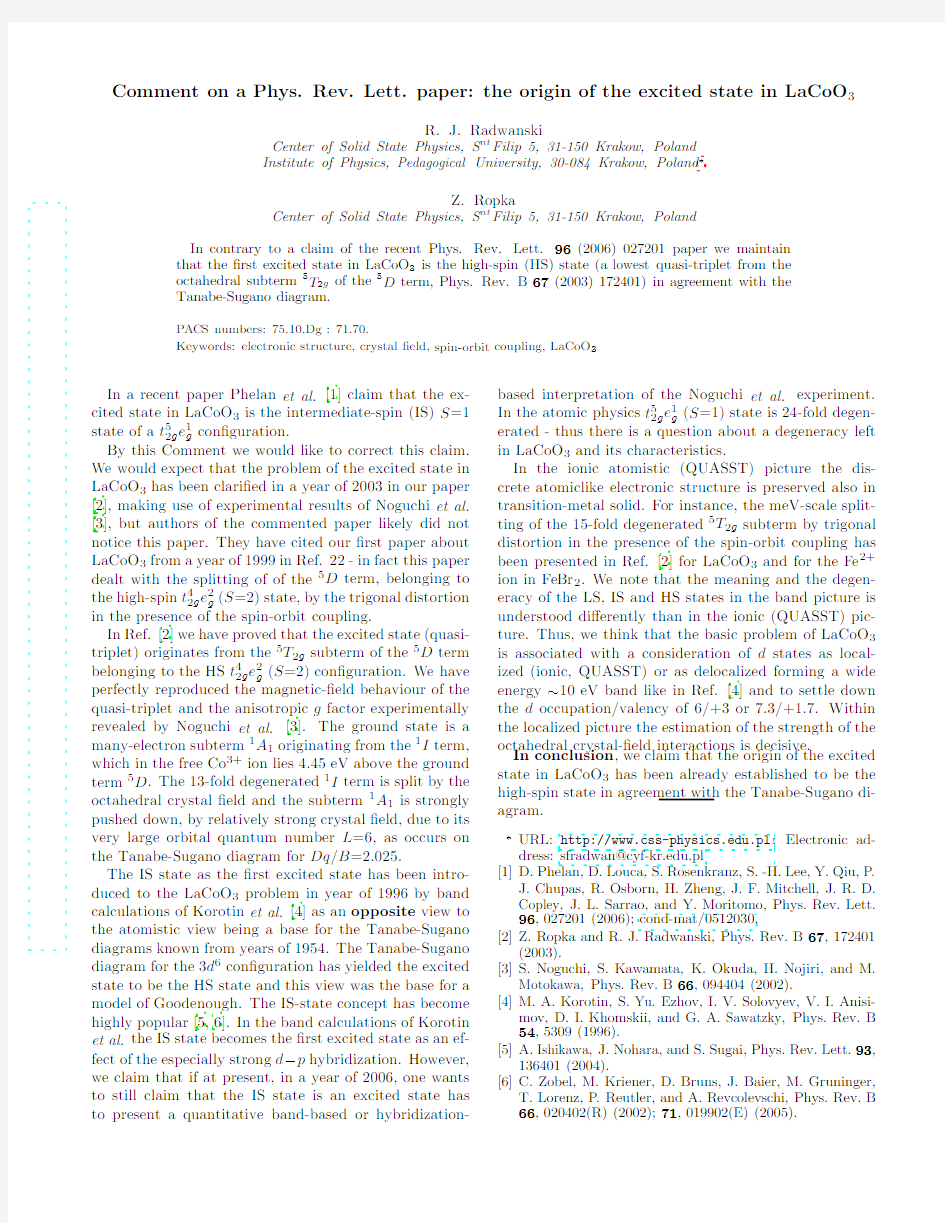Comment on a Phys. Rev. Lett. paper the origin of the excited state in LaCoO3

a r X i v :c o n d -m a t /0603812v 1 [c o n d -m a t .s t r -e l ] 30 M a r 2006
Comment on a Phys.Rev.Lett.paper:the origin of the excited state in LaCoO 3
R.J.Radwanski
Center of Solid State Physics,S nt Filip 5,31-150Krakow,Poland Institute of Physics,Pedagogical University,30-084Krakow,Poland ?
Z.Ropka
Center of Solid State Physics,S nt Filip 5,31-150Krakow,Poland
In contrary to a claim of the recent Phys.Rev.Lett.96(2006)027201paper we maintain that the ?rst excited state in LaCoO 3is the high-spin (HS)state (a lowest quasi-triplet from the octahedral subterm 5T 2g of the 5D term,Phys.Rev.B 67(2003)172401)in agreement with the Tanabe-Sugano diagram.
PACS numbers:75.10.Dg :71.70.
Keywords:electronic structure,crystal ?eld,spin-orbit coupling,LaCoO 3
In a recent paper Phelan et al.[1]claim that the ex-cited state in LaCoO 3is the intermediate-spin (IS)S =1
state of a t 52g e 1
g con?guration.
By this Comment we would like to correct this claim.We would expect that the problem of the excited state in LaCoO 3has been clari?ed in a year of 2003in our paper [2],making use of experimental results of Noguchi et al.[3],but authors of the commented paper likely did not notice this paper.They have cited our ?rst paper about LaCoO 3from a year of 1999in Ref.22-in fact this paper dealt with the splitting of of the 5D term,belonging to
the high-spin t 42g e 2
g (S =2)state,by the trigonal distortion in the presence of the spin-orbit coupling.
In Ref.[2]we have proved that the excited state (quasi-triplet)originates from the 5T 2g subterm of the 5D term
belonging to the HS t 42g e 2
g (S =2)con?guration.We have perfectly reproduced the magnetic-?eld behaviour of the quasi-triplet and the anisotropic g factor experimentally revealed by Noguchi et al.[3].The ground state is a many-electron subterm 1A 1originating from the 1I term,which in the free Co 3+ion lies 4.45eV above the ground term 5D .The 13-fold degenerated 1I term is split by the octahedral crystal ?eld and the subterm 1A 1is strongly pushed down,by relatively strong crystal ?eld,due to its very large orbital quantum number L =6,as occurs on the Tanabe-Sugano diagram for Dq /B =2.025.
The IS state as the ?rst excited state has been intro-duced to the LaCoO 3problem in year of 1996by band calculations of Korotin et al.[4]as an opposite view to the atomistic view being a base for the Tanabe-Sugano diagrams known from years of 1954.The Tanabe-Sugano diagram for the 3d 6con?guration has yielded the excited state to be the HS state and this view was the base for a model of Goodenough.The IS-state concept has become highly popular [5,6].In the band calculations of Korotin et al.the IS state becomes the ?rst excited state as an ef-fect of the especially strong d ?p hybridization.However,we claim that if at present,in a year of 2006,one wants to still claim that the IS state is an excited state has to present a quantitative band-based or hybridization-
based interpretation of the Noguchi et al.experiment.
In the atomic physics t 52g e 1
g (S =1)state is 24-fold degen-erated -thus there is a question about a degeneracy left in LaCoO 3and its characteristics.
In the ionic atomistic (QUASST)picture the dis-crete atomiclike electronic structure is preserved also in transition-metal solid.For instance,the meV-scale split-ting of the 15-fold degenerated 5T 2g subterm by trigonal distortion in the presence of the spin-orbit coupling has been presented in Ref.[2]for LaCoO 3and for the Fe 2+ion in FeBr 2.We note that the meaning and the degen-eracy of the LS,IS and HS states in the band picture is understood di?erently than in the ionic (QUASST)pic-ture.Thus,we think that the basic problem of LaCoO 3is associated with a consideration of d states as local-ized (ionic,QUASST)or as delocalized forming a wide energy ~10eV band like in Ref.[4]and to settle down the d occupation/valency of 6/+3or 7.3/+1.7.Within the localized picture the estimation of the strength of the octahedral crystal-?eld interactions is decisive.
In conclusion ,we claim that the origin of the excited state in LaCoO 3has been already established to be the high-spin state in agreement with the Tanabe-Sugano di-agram.
?
URL:https://www.360docs.net/doc/5d11510599.html,.pl ;Electronic ad-dress:sfradwan@https://www.360docs.net/doc/5d11510599.html,.pl
[1]
D.Phelan,D.Louca,S.Rosenkranz,S.-H.Lee,Y.Qiu,P.J.Chupas,R.Osborn,H.Zheng,J.F.Mitchell,J.R.D.Copley,J.L.Sarrao,and Y.Moritomo,Phys.Rev.Lett.96,027201(2006);cond-mat/0512030.
[2]Z.Ropka and R.J.Radwanski,Phys.Rev.B 67,172401(2003).
[3]S.Noguchi,S.Kawamata,K.Okuda,H.Nojiri,and M.Motokawa,Phys.Rev.B 66,094404(2002).
[4]M.A.Korotin,S.Yu.Ezhov,I.V.Solovyev,V.I.Anisi-mov,D.I.Khomskii,and G.A.Sawatzky,Phys.Rev.B 54,5309(1996).
[5]A.Ishikawa,J.Nohara,and S.Sugai,Phys.Rev.Lett.93,136401(2004).
[6]
C.Zobel,M.Kriener,
D.Bruns,J.Baier,M.Gruninger,T.Lorenz,P.Reutler,and A.Revcolevschi,Phys.Rev.B 66,020402(R)(2002);71,019902(E)(2005).
